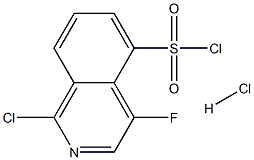To a 200-mL-capacity reactor equipped with a stirrer, a thermometer, a condenser, and a dropper, sulfuric anhydride (94.3 g, 1.18 mol) which had been liquefied through heating at 20°C to 35°C was added, and the internal temperature was adjusted to 26°C to 34°C. While the internal temperature was maintained, 4-fluoroisoquinoline sulfuric acid salt (33.33 g, 0.136 mol) produced in Example 2 was gradually added to the reactor. Thereafter, the internal temperature of the reactor was adjusted to 30°C, and the content was stirred for 13 hours. Thionyl chloride (89.0 g, 0.75 mol) was added dropwise to the reaction mixture, followed by heating to 70°C and stirring for four hours. After completion of reaction, the reactor was cooled. Water (333 mL), ice (600 g), and methylene chloride (500 mL) were added to another reactor (capacity: 3 L), and the reactor was cooled to 0°C or lower. While the internal temperature was carefully controlled so as not to exceed 5°C, the reaction mixture was gradually added dropwise to the reactor. Subsequently, sodium hydrogencarbonate (330 g) was gradually added to the mixture while the internal temperature was maintained at 5°C to 10°C, and the formed inorganic salt was removed through filtration. The filtrate was separated, and the aqueous layer was extracted with methylene chloride (333 mL). Collected organic layers were combined, and the combined organic layer was washed with saturated brine (166 mL), followed by drying through addition of sodium sulfate anhydrate (21 g) to the washed layer. After removal of the drying agent through filtration, methylene chloride was added to the organic layer so as to adjust the total volume to 1.2 L. Then, 4N HC1/EtOAc (41 mL) was added dropwise to the organic layer at 18 to 21°C, followed by stirring at 30°C for one hour. The precipitated crystals were collected through filtration and washed with methylene chloride (110 mL), to thereby yield 17.42 g of 4-fluoroisoquinoline-5-sulfonyl chloride hydrochloride (45.4%) as white crystals.
4-Fluoro-5-isoquinolinesulfonyl chloride hydrochloride (1:1) can be used as organic synthesis intermediate and pharmaceutical intermediate, mainly used in laboratory research and development process and chemical production process.

